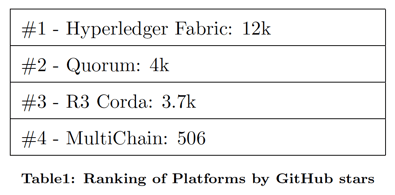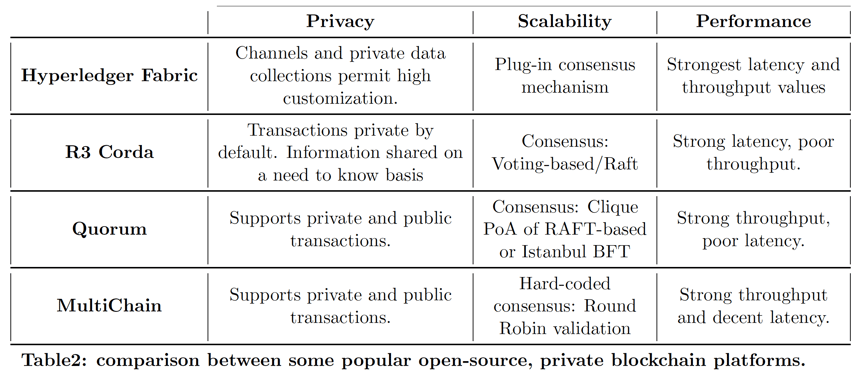A PDF version of this article is available here.
1. Introduction
Blockchain technology has the potential to revolutionize the handling of data in all industry sectors and finance is no exception. In this brief article we seek to compare, in a broad sense, Hyperledger Fabric (HF from now on) with other leading blockchain platforms in the context of building a financial exchange. Only permissioned blockchain platforms that support smart contracts are considered, as these are indispensable features of the project at hand. In addition, we have also restricted ourselves to open-sourced platforms, since any blockchain solution would benefit greatly from a community that further develops the platform it is running on.
With this criteria in mind, we will compare HF to Quorum, R3 Corda, MultiChain. It is important to keep in mind that, due to the novelty of the technology and the scarcity of test studies, this article is meant to provide only a modest guideline for comparison among the different platforms.
This article is organized as follows: Section 2 is meant to provide some generic information about each of the platforms. Section 3 is meant to display some aspects that make HF stand out among the other platforms. In Section 4, we present some non-functional requirements that any exchange platform would have to possess. Lastly, in Section 5 we compare the different platforms against these requirements.
2. Platform Overview
Hyperledger Fabric is an enterprise-grade, distributed ledger platform that offers modularity and versatility for a broad set of industry use cases [4]. It is an important project under the Hyperledger project umbrella, hosted by the Linux Foundation. It is its modular architecture that makes it stand out, which includes many plug and play components, such as consensus, privacy and membership services.
R3 Corda is a permissioned blockchain platform specially oriented to the financial industry. As stated in its whitepaper: “The motivating problem, which Corda seeks to solve, is the problem of managing contracts and other agreements between any combination of firms and individuals, especially when those parties trust each other enough to trade but not enough to have their counterparty maintain all the records”[9]. It is the most specialized among the platforms considered in this article.
Quorum is an enterprise blockchain platform initially developed by J.P.Morgan to be deployed in the financial sector. Its use has since expanded to a variety of industry sectors. It is a fork from go-ethereum, with several modifications to better support business needs.
MultiChain, developed by Coin Sciences, is an open source platform which is a fork of the Bitcoin blockchain. It has been enhanced in order to allow it to operate as a permissioned network.
3. Hyperledger Fabric - A Promising Candidate
We begin by pointing out some general facts that present HF as a good option not only for blockchain projects related to the financial industry but more generally any enterprise-blockchain project.
HF is hosted by the Linux Foundation, the world leading open-source community. This gives Fabric an edge over other blockchain platforms, as a larger community generally translates into a faster development of the platform and a broader range of features. This is specially relevant in a relatively new, dynamic and largely untested environment as is enterprise-blockchain implementation.
Although, not necessarily true, but highly representative of the usage of each platform are the Github starts
they have. The ones that have the more stars in decreasing order are: HF > Quorum > Corda > Multichain (see Table1 below for exact numbers). Moreover “[Hyperledger] is a global collaboration, …, including leaders in finance, banking, Internet of Things, supply chain, manufacturing and Technology. This structure gives it the potential to become the de-facto standard which will become an important adoption criterion going forward”[1]. Some big companies already using Fabric include Amazon, PayPal, Walmart and IBM.

Due to all the aforementioned, it is reasonable to think that employing your blockchain project with Fabric will make it easier to continue developing it in the future due to its vast open-source community and business involvement.
Furthermore, as Fabric is poised to become the enterprise- blockchain standard, it is likely that blockchains powered by Fabric will boast of better compatibility with other DLT(Distributed ledger technology) arrangements and/or off-ledger systems.
4. Requirements of an exchange platform
Any functioning exchange platform must be able to (i) give certain guarantees of privacy (ii) process a large number of transactions and (iii) provide a relatively short transaction time.
● Privacy: current industry practices restrict data sharing and distribution to only intended stakeholders. Any aspiring platform will have to be able to enforce the current regulations, whichever they may be.
● Performance: a big part of the push for developing blockchain-based financial systems is the supposed reduction in transaction time that would come from such an implementation. Such a platform must therefore be able to handle many transactions within quick or reasonable time. Performance is thus an important factor when evaluating blockchain solutions for financial systems.
The two most commonly used metrics to measure performance are throughput and latency. Throughput is measured as the number of successful transactions per second starting from the first transaction deployment time. Latency is the response time, that is, the difference between completion time and the deployment time, for each transaction.
● Scalability: scalability is basically a measure of how well a blockchain can maintain its performance as the network is subjected to an increasingly large volume of transactions and/or more nodes are added to the network. It is of great importance for any large enough exchange platform to be scalable.
5. HF and other platforms
In this section we compare the platform HF to Quorum, R3 Corda, MultiChain. More specifically we compare them against the non-functional requirements given in the previous section. For a table comparison of the features discussed below see table2.
● Privacy: the platforms we are considering are permissioned networks that intend to guarantee a certain level of privacy. All of them are based on public key infrastructure (PKI) and support the exchange of private messages and transactions.
HF presents great flexibility in this respect, as it allows users to explicitly configure privacy via channels or private data collections. This, though adding more complexity to the network management, especially when there are a lot of participants, offers fine-grained control over who can access the data[5]. When a transaction is confirmed in HF, all the users of the network can see that a transaction has taken place but only some pertinent users will be able to access the data that it carries.
In contrast, Corda transactions are private by default and confidential credentials make it possible to hide identities from future asset owners, a feature which as of yet is not provided in HF. Moreover, transactions are only shared with the parties that need to know about the transaction, and not the entire network [6]. This makes the Corda framework stand apart from most blockchain solutions as it doesn’t have a global state. Data is instead shared and verified from node to node on a need-to-know basis [5].
Quorum presents a quite simple approach when it comes to transaction privacy. Transactions in Quorum are either “Private Transactions” or “Public Transactions”. Both types are broadcasted to the whole network and in a similar fashion to HF, only certain users can access the data of “Private Transactions”[7]. MultiChain operates in a similar manner [8].
In the study conducted in [3], the authors give HF the highest privacy score, followed by Quorum and MultiChain. R3 Corda is, quite counterintuitively, given the lowest score.
● Scalability: in this section it is important to distinguish the degree of flexibility that a platform has in respect to the consensus mechanism it employs. This is because different consensus mechanisms work better in different situations. Thus, if your platform can implement a wider variety of such mechanisms, it is likely that it will adapt better to changing scenarios, such as an increase in the volume of transactions. In this metric, MultiChain is the most restrictive of the platforms due to its unique hard-coded consensus mechanism. Quorum and Corda do, in contrast, support more than one protocol. However, it is HF, with its pluggable consensus feature [4] that displays by far the most flexibility in this respect.
● Performance: according to [3], HF boasts of a higher throughput and shorter latency than the other platforms. One must bear in mind however, that there exists no work that compares all the frameworks in the same settings [3]. The comparison conducted in [3] only allows us to merely see to which levels of performance each network is known to be able to reach.

6. Conclusion
Blockchain for enterprises is an emerging and largely uncharted domain with pulsating potential but with as of yet few instances of use cases and a limited literature. As such, no direct comparisons have been made between the different blockchain platforms available. In order to contrast them, one is limited to pointing out their different features and undertaking an entirely qualitative analysis.
This article aimed to provide the reader with a basic understanding of the differences among some major permissioned blockchain platforms, with a special focus on HF. We explore features relevant for a financial system (although the features previously discussed are relevant in almost any kind of enterprise-related blockchain project).
After reviewing the basic characteristics of each of the platforms, HF appears to provide a greater degree of flexibility in regard to privacy and consensus mechanisms than the rest. This allows a project developed with HF to deploy a wide range of confidentiality policies and should help it scale properly. In addition, it has the backing of the world’s largest open source community, which should allow it to develop at a rapid pace. This is specially important in the context of a young technology which will likely need further refinement in order to accommodate all the features of a financial system.
However, all blockchain platforms are different and the optimal choice among them may very well depend on the specifications of the project at hand.
References:
[1] https://www.hfsresearch.com/blockchain/blockchain-not-ready-but-hyperledger-fabric-release-show-the-way_071217/
[2] http://uu.diva-portal.org/smash/get/diva2:1313719/FULLTEXT01.pdf
[3] https://www.sciencedirect.com/science/article/pii/S2405959520301909
[4] https://www.hyperledger.org/wp-content/uploads/2020/03/hyperledger_fabric_whitepaper.pdf
[5] https://labs.eleks.com/2021/04/distributed-ledger-frameworks-comparison-corda-vs-hyperledger-fabric.html
[6] https://www.corda.net/blog/open-source-but-private-a-case-for-private-decentralized-ledger-tech/
[7] https://docs.goquorum.consensys.net/en/stable/Concepts/Privacy/PrivateAndPublic/
[8] multichain.com/developers/stream-confidentiality/
[9] https://www.r3.com/wp-content/uploads/2019/06/corda-platform-whitepaper.pdf




